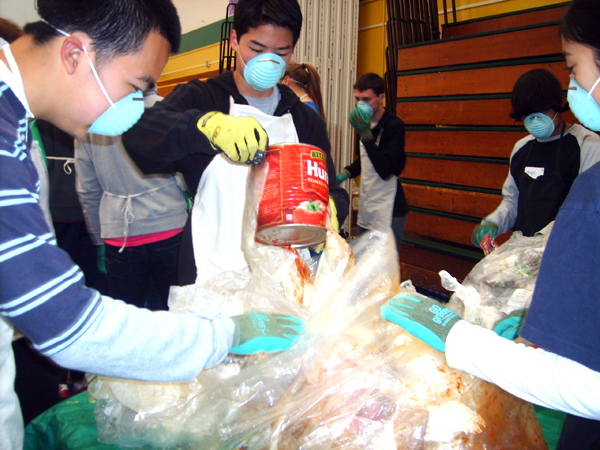CVHS undergoes waste audit
“Reduce, reuse, recycle! Reduce, reuse, recycle…” blasted from the speakers of the large gym where students from Leadership, Smart Energy Club, and American Cancer Society helped out in conducting a waste audit by digging through bags and bags of smelly garbage.
“A waste audit is when you take all the garbage from the day before to see what can be recycled and what is waste,” said Su-Lin Terhell, Leadership student and environmental commissioner.
Waste was sorted into three general categories: organics, recyclables, and garbage. Organics are things such as food scraps and food-soiled paper. Recyclables consist of things like bottles and dry paper (because of the rain, a lot of paper was wet and actually had to be put in organics). Film plastic, such as Ziploc bags and plastic shopping bags, were put in a separate bag to be recycled. Actual garbage consisted of things such as plastic utensils and chip bags. Hazardous waste, such as an HP laptop charger, was a different category.
Equipped with gloves, masks, and aprons provided by the Castro Valley Sanitary District, the students were ready. Bag after bag after bag, the students pulled out organics, recyclables, and garbage and put them in separate small trash cans. After the trash cans were filled, the bags were taken out and put aside. There were three rows of bags for the three categories of waste.
“It’s really important for schools [to have a waste audit] because it shows students what could be recycled instead of going to a landfill,” said Michelle Knudson, Castro Valley Sanitary District solid waste program intern.
Chemistry teacher Deborah Yager, who also spent her Saturday morning at the waste audit sorting garbage, agreed and said, “It’s an opportunity to see with your own eyes how much waste our school community can create in one day. It’s also sobering to see how much doesn’t have to go in a landfill.”
After almost four hours, all the trash was sorted. Most of the garbage was actually organics and could be composted. Recyclables made up the second largest category, garbage the smallest.
Garbage disposal currently costs the school $50,000 a year. However, if the school were to only produce the amount of garbage sorted, with the rest separated as compost or recyclables, it would only cost $10,000.
Although it was a rather icky experience, it was also interesting. As Mary Doronkina, sophomore and Smart Energy Club member, put it, “It was an amazing experience. I had so much fun separating compost, recyclables, and garbage with my buddies.”
This waste audit is a step in earning the Green Ribbon Award, part of a program the Castro Valley Sanitary District started back in 2007. Since then, this award has been given to elementary schools, middle schools, and the adult school.
This is the first time a waste audit has been done at CVHS, but it has been done at other schools in the district. Doing a waste audit here was harder because CVHS is a lot bigger with more people than other schools, as Terhell points out.
In the end, students walked away tired, inspired, happy, and a bit smelly.
“I feel like I slept in a trash can,” Doronkina joked. “A nice trash can. I need a bubble bath.”

